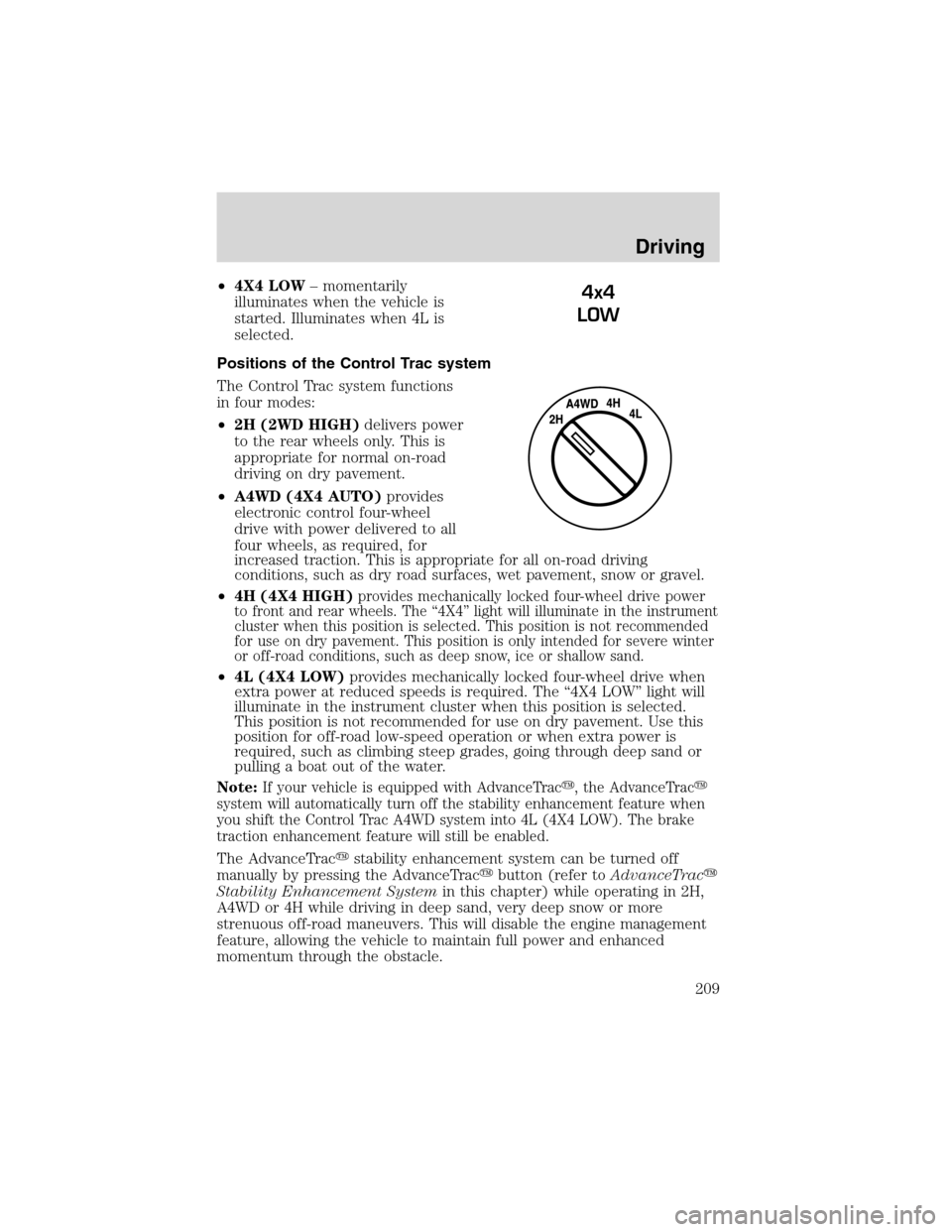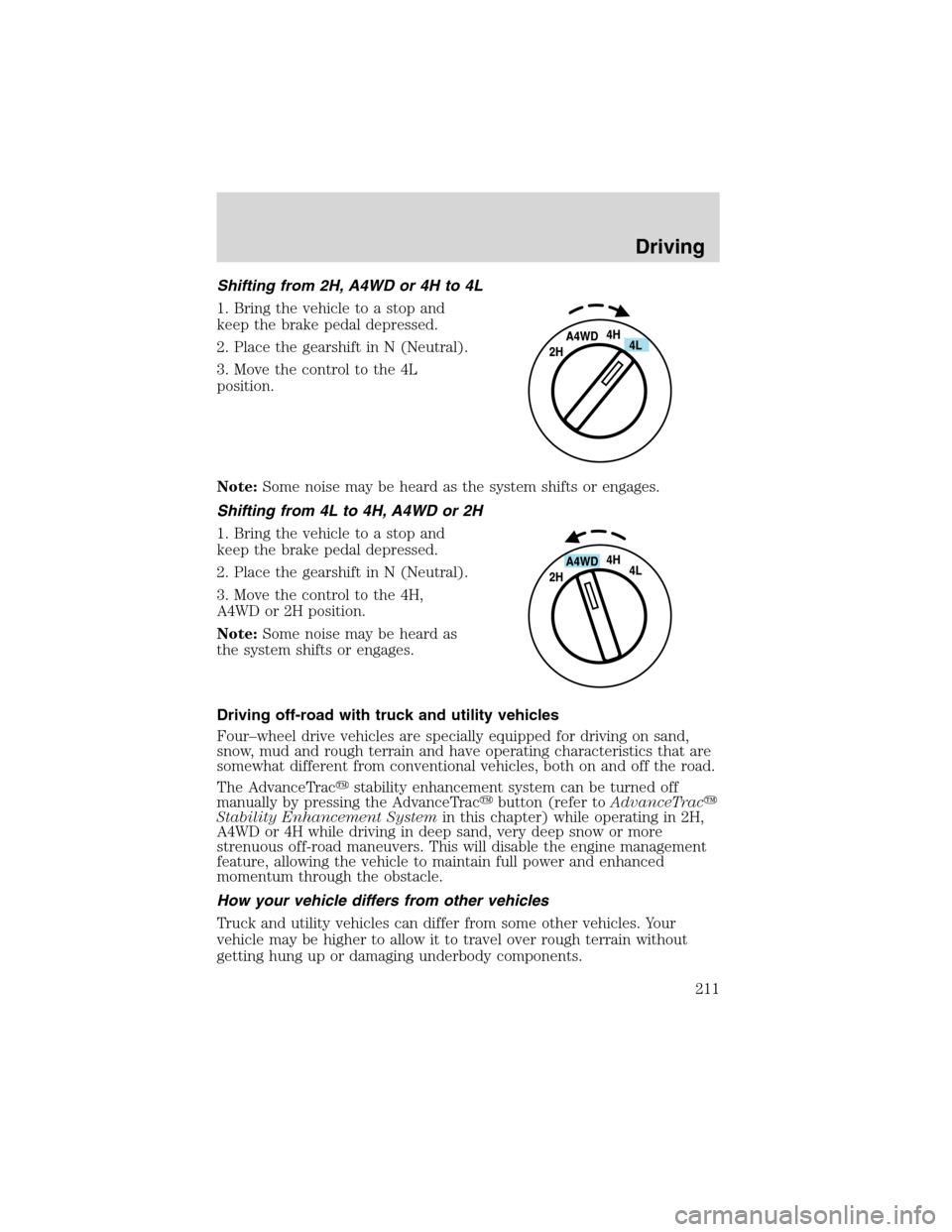Page 208 of 320

Always keep the sensors (located on the rear bumper/fascia) free
from dirt, snow and ice (do not clean the sensors with sharp
objects). These elements may cause the system to operate
inaccurately.
If the vehicle sustains damage to the rear bumper/fascia, leaving
it misaligned or bent, the sensing zone may be altered causing
inaccurate measurement of obstacles or false alarms.
CONTROL TRAC FOUR-WHEEL DRIVE (4X4) OPERATION
(IF EQUIPPED)
For important information regarding safe operation of this type
of vehicle, seePreparing to drive your vehiclein this chapter.
If equipped with the Control Trac 4x4 System, and 4L (4x4 LOW)
is selected while the vehicle is moving, the system will not
engage. This is normal and should be no reason for concern.
Before 4L (4x4 LOW) can be engaged, the vehicle must be
brought to a complete stop, the brake pedal depressed and the
transmission placed in N (Neutral).
The vehicle should not be operated in 4H (4x4 HIGH) or 4L (4x4 LOW)
on dry pavement. Doing so could result in difficult disengagement of the
transfer case, increased tire wear, decreased fuel economy and may
damage driveline components.
Your 4x4 features the heavy-duty Control Trac system which includes a
computer-operated transfer case. This unique system is interactive with
the road, continually monitoring and adjusting torque delivery to the
front and rear wheels to optimize vehicle control.
System indicator lights
The Control Trac system indicator lights illuminate only under the
following conditions. If these lights illuminate when driving in 2H or
A4WD, contact your Ford dealer as soon as possible.
•4X4 HIGH- momentarily
illuminates when the vehicle is
started. Illuminates when 4H is
selected.
4x4
HIGH
Driving
208
Page 209 of 320

•4X4 LOW–momentarily
illuminates when the vehicle is
started. Illuminates when 4L is
selected.
Positions of the Control Trac system
The Control Trac system functions
in four modes:
•2H (2WD HIGH)delivers power
to the rear wheels only. This is
appropriate for normal on-road
driving on dry pavement.
•A4WD (4X4 AUTO)provides
electronic control four-wheel
drive with power delivered to all
four wheels, as required, for
increased traction. This is appropriate for all on-road driving
conditions, such as dry road surfaces, wet pavement, snow or gravel.
•4H (4X4 HIGH)
provides mechanically locked four-wheel drive power
to front and rear wheels. The“4X4”light will illuminate in the instrument
cluster when this position is selected. This position is not recommended
for use on dry pavement. This position is only intended for severe winter
or off-road conditions, such as deep snow, ice or shallow sand.
•4L (4X4 LOW)provides mechanically locked four-wheel drive when
extra power at reduced speeds is required. The“4X4 LOW”light will
illuminate in the instrument cluster when this position is selected.
This position is not recommended for use on dry pavement. Use this
position for off-road low-speed operation or when extra power is
required, such as climbing steep grades, going through deep sand or
pulling a boat out of the water.
Note:
If your vehicle is equipped with AdvanceTrac�, the AdvanceTrac�
system will automatically turn off the stability enhancement feature when
you shift the Control Trac A4WD system into 4L (4X4 LOW). The brake
traction enhancement feature will still be enabled.
The AdvanceTrac�stability enhancement system can be turned off
manually by pressing the AdvanceTrac�button (refer toAdvanceTrac�
Stability Enhancement Systemin this chapter) while operating in 2H,
A4WD or 4H while driving in deep sand, very deep snow or more
strenuous off-road maneuvers. This will disable the engine management
feature, allowing the vehicle to maintain full power and enhanced
momentum through the obstacle.
4x4
LOW
Driving
209
Page 210 of 320
Utility and four-wheel drive vehicles arenotdesigned for
cornering at speeds as high as passenger cars any more than
low-slung sports cars are designed to perform satisfactorily under
off-road conditions. Avoid sharp turns or abrupt maneuvers in these
vehicles.
Note:The Control Trac selector knob should not be changed while the
rear wheels are slipping.
Using the Control Trac system
Shifting from 2H to A4WD or 4H
Move the control to the A4WD or
4H position at any forward speed up
to 88 km/h (55 mph). The“4X4”
light in the instrument cluster will
illuminate if 4H is selected.
Shifting from A4WD to 4H
Move the control from A4WD to 4H
at a stop or while driving at any
speed.
Driving
210
Page 211 of 320

Shifting from 2H, A4WD or 4H to 4L
1. Bring the vehicle to a stop and
keep the brake pedal depressed.
2. Place the gearshift in N (Neutral).
3. Move the control to the 4L
position.
Note:Some noise may be heard as the system shifts or engages.
Shifting from 4L to 4H, A4WD or 2H
1. Bring the vehicle to a stop and
keep the brake pedal depressed.
2. Place the gearshift in N (Neutral).
3. Move the control to the 4H,
A4WD or 2H position.
Note:Some noise may be heard as
the system shifts or engages.
Driving off-road with truck and utility vehicles
Four–wheel drive vehicles are specially equipped for driving on sand,
snow, mud and rough terrain and have operating characteristics that are
somewhat different from conventional vehicles, both on and off the road.
The AdvanceTrac�stability enhancement system can be turned off
manually by pressing the AdvanceTrac�button (refer toAdvanceTrac�
Stability Enhancement Systemin this chapter) while operating in 2H,
A4WD or 4H while driving in deep sand, very deep snow or more
strenuous off-road maneuvers. This will disable the engine management
feature, allowing the vehicle to maintain full power and enhanced
momentum through the obstacle.
How your vehicle differs from other vehicles
Truck and utility vehicles can differ from some other vehicles. Your
vehicle may be higher to allow it to travel over rough terrain without
getting hung up or damaging underbody components.
Driving
211